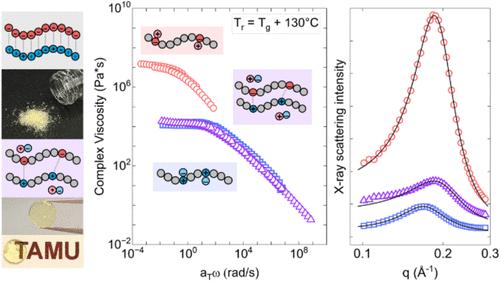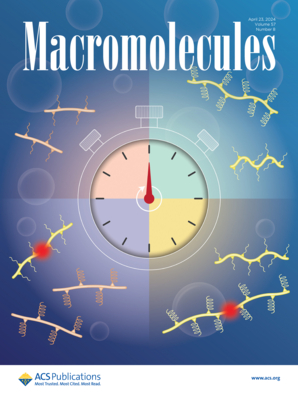Microstructure and Viscoelasticity of Oppositely Charged Ionomer Blend Melts
IF 5.1
1区 化学
Q1 POLYMER SCIENCE
引用次数: 0
Abstract
The electrostatic bonding between oppositely charged polymers results in polyelectrolyte complexes (PECs) with permanent shapes. However, the nearly complete suppression of chain diffusion renders PECs brittle and difficult to process without hydration and plasticization. This study investigates the viscoelastic behavior of ionomers (charge density ≤20 mol %) and the binary blends with oppositely charged counterparts. Unlike dried PECs, ionomer blends demonstrate inherent thermal reprocessability without the need for plasticizers. By varying the identity of the charged group, the charge density, and the ion distribution along the polymer chain, we achieve tunable linear viscoelastic (LVE) responses across a broad frequency range. The LVE behavior fits a sticky Rouse model, where strong net ionic interactions in the ionomers result in an extended elementary Rouse segment relaxation time τ0 and ionic association lifetime τs. Notably, anionic ionomers with potassium sulfonate groups display more pronounced relaxation delays. Interestingly, after glass transition normalization, the viscosity of the blend aligns with that of the cationic parent ionomer, but is significantly lower than that of the anionic counterpart. This demonstrates a distinct outcome from the PEC system, as in most cases, higher viscosity is observed from blending oppositely charged polyelectrolytes (PEs). X-ray scattering analysis attributes the high viscosity of the anionic ionomer to potassium sulfonate ion clusters (approximately 1–2 nm in diameter) acting as transient physical cross-links, which are disrupted upon blending due to salt metathesis. Furthermore, placing charged monomers at the chain end results in ion-induced microphase separation, enhancing thermoplastic elasticity. This study offers fundamental insights into the structure–property relationships of ionomers and their blends, highlighting a big design space and their potential as reprocessable structural materials.

求助全文
约1分钟内获得全文
求助全文
来源期刊

Macromolecules
工程技术-高分子科学
CiteScore
9.30
自引率
16.40%
发文量
942
审稿时长
2 months
期刊介绍:
Macromolecules publishes original, fundamental, and impactful research on all aspects of polymer science. Topics of interest include synthesis (e.g., controlled polymerizations, polymerization catalysis, post polymerization modification, new monomer structures and polymer architectures, and polymerization mechanisms/kinetics analysis); phase behavior, thermodynamics, dynamic, and ordering/disordering phenomena (e.g., self-assembly, gelation, crystallization, solution/melt/solid-state characteristics); structure and properties (e.g., mechanical and rheological properties, surface/interfacial characteristics, electronic and transport properties); new state of the art characterization (e.g., spectroscopy, scattering, microscopy, rheology), simulation (e.g., Monte Carlo, molecular dynamics, multi-scale/coarse-grained modeling), and theoretical methods. Renewable/sustainable polymers, polymer networks, responsive polymers, electro-, magneto- and opto-active macromolecules, inorganic polymers, charge-transporting polymers (ion-containing, semiconducting, and conducting), nanostructured polymers, and polymer composites are also of interest. Typical papers published in Macromolecules showcase important and innovative concepts, experimental methods/observations, and theoretical/computational approaches that demonstrate a fundamental advance in the understanding of polymers.
 求助内容:
求助内容: 应助结果提醒方式:
应助结果提醒方式:


